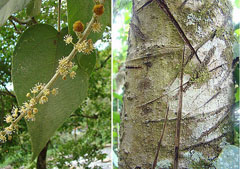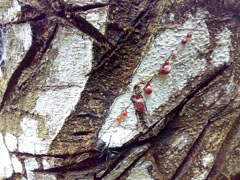 |
|
Dick Culbert flickr |
 |
| por natikka arteyfotografia.com.ar |
Translate this page:
Summary
Sangre de Grado (Croton lechleri) is a flowering plant with a broad but open crown native to north western South America. It grows up to 20 meters in height with bole diameter of usually 30 cm. It is also known as Sangre de Drago. It is characterized by its thick red latex that has medicinal properties. It is used as a liquid bandage for wounds and other skin-related injuries and disorders. It is an effective antiviral treatment and is also used in the treatment of tumours. Native to northwestern South America. Also known as: Sangre de Grado (Peruvian Spanish), Sangre de Drago (Ecuadorian Spanish), Dragon's blood.
Physical Characteristics

 Croton lechleri is an evergreen Tree growing to 12 m (39ft) by 12 m (39ft) at a fast rate.
Croton lechleri is an evergreen Tree growing to 12 m (39ft) by 12 m (39ft) at a fast rate.
See above for USDA hardiness. It is hardy to UK zone 10.
Suitable for: light (sandy), medium (loamy) and heavy (clay) soils and prefers well-drained soil. Suitable pH: mildly acid, neutral and basic (mildly alkaline) soils. It cannot grow in the shade. It prefers moist soil. The plant can tolerates strong winds but not maritime exposure.
UK Hardiness Map
US Hardiness Map
Synonyms
C. draco cordatus Müll.Arg. Oxydectes lechleri (Müll.Arg.) Kuntze
Plant Habitats
Edible Uses
References More on Edible Uses
Medicinal Uses
Plants For A Future can not take any responsibility for any adverse effects from the use of plants. Always seek advice from a professional before using a plant medicinally.
Antibacterial Antifungal Antihaemorrhoidal Antiinflammatory Antipruritic Antitumor Antiviral Cancer
Odontalgic Skin Stings Vulnerary
Sangre de grado is a common name for several trees in the genus Croton - all have a red sap and can be used interchangeably. The sap is a popular and effective herbal treatment, and so it is commonly harvested from the wild for both local use and for trade. It is also an ingredient of commercial cosmetic preparations. The red sap or latex (and also its bark) has a long history of indigenous use in the rainforest and in South America. The curative power of the sap was widely known throughout the indigenous tribes of Mexico, Peru, and Ecuador. Modern research has shown that it is a very effective treatment for a wide range of injuries and disorders, particularly relating to the skin; both internal and external ulcers; is an effective antiviral and also helps in the treatment of tumours[ 318 ]. The resin or sap is a storehouse of phytochemicals including proanthocyanidins (antioxidants), simple phenols, diterpenes, phytosterols, and biologically active alkaloids and lignans Scientists have attributed many of the biologically active properties of the sap (especially its wound-healing capacity) to two main 'active' constituents: an alkaloid named taspine, and a lignan named dimethylcedrusine[ 318 ]. Taspine has been shown to have anti-inflammatory, antitumor and antiviral actions, and to be active against the herpes virus[ 318 ]. The lignan 'dimethylcedrusine' has been shown to play a central role in the resin's effective wound-healing action. The study revealed that the crude resin stimulated the contraction of wounds, helped in the formation of a crust/scab at the wound site, regenerated skin more rapidly, and assisted in the formation of new collagen[ 318 ]. Other phytochemicals, including phenolic compounds, proanthocyanidins, and diterpenes, have shown potent antibacterial activity (against E. Coli and Bacillus subtilis) as well as wound-healing properties[ 318 ]. Research has shown that the resin is a potent, cost-effective treatment for gastrointestinal ulcers and distress via antimicrobial, anti-inflammatory, and sensory afferent-dependent actions[ 318 ]. The resin has also shown an in vitro effect against stomach cancer and colon cancer cells[ 318 ]. It inhibits the growth of a human myelogenous leukaemia cell line and also prevents cells from mutating in test tube studies[ 318 ]. The sap is antibacterial, antifungal, anti-inflammatory, antimicrobial, antipruritic, antitumor, haemostatic and vulnerary[ 318 ]. It is used internally in the treatment of intestinal and stomach ulcers; upper respiratory viruses; stomach viruses; and HIV[ 318 , 355 ]. For internal use, the traditional remedy is 10 - 15 drops in a small amount of liquid, taken 1-3 times daily (be prepared, however; it tastes quite dreadful)[ 318 ]. It is taken as a douche for relieving vaginal discharge[ 318 ]. The sap is painted on wounds to staunch bleeding, accelerate healing, and to seal and protect injuries from infection. The sap dries quickly and forms a barrier, much like a 'second skin'. It is used as a treatment on wounds, insect bites and stings, skin disorders, fractures, and haemorrhoids., Other uses include treating inflamed or infected gums, in vaginal baths before and after childbirth, for haemorrhaging after childbirth, and for a wide range of skin disorders[ 318 , 355 ]. For external use, the resin is rubbed directly on the affected area several times daily and allowed to dry. Please note: the resin is red! It will temporarily stain the skin a reddish-brown (which will wash off), but it will permanently stain clothing. Rubbing the resin in the palm of the hand first or directly where applied will thicken the resin into a thin, lighter coloured paste, which helps form a second skin on top of a wound or rash and reduces staining[ 318 ].
References More on Medicinal Uses
The Bookshop: Edible Plant Books
Our Latest books on Perennial Plants For Food Forests and Permaculture Gardens in paperback or digital formats.

Edible Tropical Plants
Food Forest Plants for Hotter Conditions: 250+ Plants For Tropical Food Forests & Permaculture Gardens.
More

Edible Temperate Plants
Plants for Your Food Forest: 500 Plants for Temperate Food Forests & Permaculture Gardens.
More

More Books
PFAF have eight books available in paperback and digital formats. Browse the shop for more information.
Shop Now
Other Uses
Latex
Agroforestry Uses: The tree has an open, though broad crown. It intercrops well with smaller trees[ 355 ]. Other Uses: None known
Special Uses
References More on Other Uses
Cultivation details
Grows best in a well-drained, fertile soil[ 355 ]. A fast-growing tree[ 355 ].
References Carbon Farming Information and Carbon Sequestration Information
Temperature Converter
Type a value in the Celsius field to convert the value to Fahrenheit:
Fahrenheit:
The PFAF Bookshop
Plants For A Future have a number of books available in paperback and digital form. Book titles include Edible Plants, Edible Perennials, Edible Trees,Edible Shrubs, Woodland Gardening, and Temperate Food Forest Plants. Our new book is Food Forest Plants For Hotter Conditions (Tropical and Sub-Tropical).
Shop Now
Plant Propagation
Seed - Seedlings are very delicate and frequently die or succumb to grasshoppers in the wild[ 355 ].
Other Names
If available other names are mentioned here
Sangre de Grado (Croton lechleri). Also known as: Sangre de Grado (Peruvian Spanish), Sangre de Drago (Ecuadorian Spanish), Dragon's blood.
Native Range
SOUTHERN AMERICA: Bolivia, Colombia, Ecuador, Peru
Weed Potential
Right plant wrong place. We are currently updating this section.
Please note that a plant may be invasive in one area but may not in your area so it's worth checking.
None Known
Conservation Status
IUCN Red List of Threatened Plants Status : This taxon has not yet been assessed

Growth: S = slow M = medium F = fast. Soil: L = light (sandy) M = medium H = heavy (clay). pH: A = acid N = neutral B = basic (alkaline). Shade: F = full shade S = semi-shade N = no shade. Moisture: D = dry M = Moist We = wet Wa = water.
Now available:
Food Forest Plants for Mediterranean Conditions
350+ Perennial Plants For Mediterranean and Drier Food Forests and Permaculture Gardens.
[Paperback and eBook]
This is the third in Plants For A Future's series of plant guides for food forests tailored to
specific climate zones. Following volumes on temperate and tropical ecosystems, this book focuses
on species suited to Mediterranean conditions—regions with hot, dry summers and cool, wet winters,
often facing the added challenge of climate change.
Read More
Expert comment
Author
Müll.Arg.
Botanical References
Links / References
For a list of references used on this page please go here
A special thanks to Ken Fern for some of the information used on this page.
Readers comment
| Add a comment |
|
If you have important information about this plant that may help other users please add a comment or link below. Only comments or links that are felt to be directly relevant to a plant will be included. If you think a comment/link or information contained on this page is inaccurate or misleading we would welcome your feedback at [email protected]. If you have questions about a plant please use the Forum on this website as we do not have the resources to answer questions ourselves.
* Please note: the comments by website users are not necessarily those held by PFAF and may give misleading or inaccurate information.
To leave a comment please Register or login here All comments need to be approved so will not appear immediately.
|
Subject : Croton lechleri
|
|
|
|